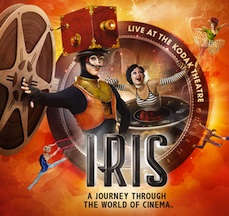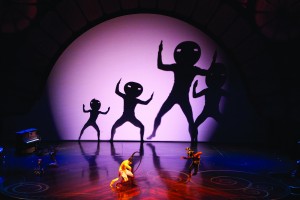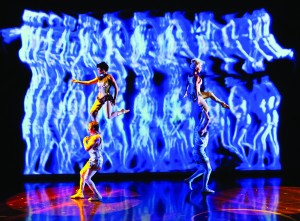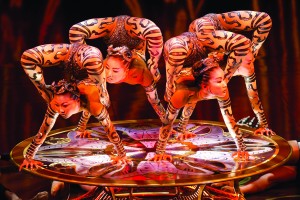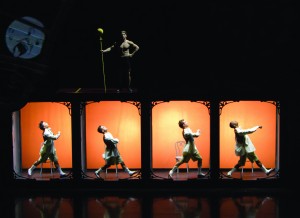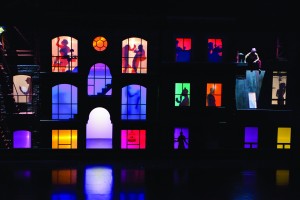CIRQUE DU CINEMA
When Quebec-based artistic troupe Cirque du Soleil creates a new resident production, they typically design the building to fit the show. Not so with Cirque du Soleil’s IRIS. Although the Kodak Theatre at Hollywood and Highland has been around for only a decade, Cirque du Soleil still spent $100 million on renovations. So, while they may have not have built the theatre around the show, they did the next closest thing: redesigning the space from the inside. The result is one of the most technologically sophisticated theatres in the world, and all of this multimedia technology and savvy is put to brilliant use in IRIS, complementing the human performances without overwhelming them.
The title IRIS refers to the human eye and what the eye sees and does not see. It signifies to the thoughtful viewer to watch carefully, since here is a show that blurs the already fuzzy line between fantasy and reality. This blurry line doesn’t merely refer to the fantastical nature of the stunts performed, but to the medium that always blurs fantasy and reality: cinema. The ability to mix fantasy and reality is precisely what makes cinema such a powerful medium. IRIS, with its heady mix of multimedia and live performance, manages to multiply this potentiality to the nth degree.
IRIS doesn’t have much of a plot. Despite being marketed as “a journey through the world of cinema,” IRIS isn’t a journey in the conventional sense of one that goes somewhere, that involves linear development or the arrival at a destination. IRIS has many characters – some of them even talk – but what little acting is involved is more along the lines of a comedy sketch or a ballet. Buster and Scarlett, the principal 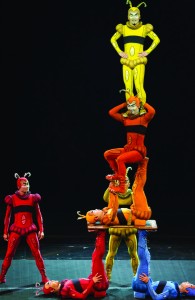 characters, express themselves primarily through movement. Both characters have obvious cinematic references, like Buster Keaton and Scarlett O’Hara. Very few cinematic references in the show refer to specific actors, characters or films, however, but rather to cinema more generally.
characters, express themselves primarily through movement. Both characters have obvious cinematic references, like Buster Keaton and Scarlett O’Hara. Very few cinematic references in the show refer to specific actors, characters or films, however, but rather to cinema more generally.
To go looking for a plot in IRIS is really to miss the point. Cirque du Soleil is a circus, after all! Some of the stunts will have you on the edge of your seat simply because you become anxious for the performers’ safety. This isn’t such a problem when the acrobats are hanging from the ceiling, but rather when they’re doing things on the ground. One scene involves lots of gymnastic Martian-like characters who do flips on top of each other without ever touching the ground, sometimes stacked four high. During the most dangerous stunts, a spotter will appear as a safety precaution. (Fortunately, most stunts came off perfectly.) Each of these acrobats is at the top of his/her game, and the level of skill and training involved in getting there is extraordinary. The beauty of it all is enough to make you cry.
Besides the more typical circus performers, like trapeze artists, IRIS includes some incredibly flexible contortionists. They do things you couldn’t possibly imagine a human being is capable of doing. And it’s not just their flexibility, but their perfect balance and strength. Of course, some of their unnatural-looking contortions are eerie and frightening, but others are beautifully elegant and graceful.
One of the strengths of IRIS is the sheer variety of the show. No scene or performance goes on too long, and there are smooth transitions – and a good balance – between comedy and drama, the sinister and the whimsical. Scenes also vary from the utter simplicity of a single girl on a swing to a tightly choreographed ensemble set piece involving dozens of performers. In the latter, there is so much going on that you don’t know where to look. Consequently, it’s impossible to take it all in; it’s simply overwhelming. And one might add that the show isn’t confined to the stage. Both before the official start and during the intermission, cast members can be seen up close, entertaining the audience in the aisles and lobby areas.
Cirque du Soleil’s IRIS is simply magical! From the specially designed props to the colorful, period-inspired costumes, every aspect of the show is a work of great artistry. Projection screens mimic the live performances, provide moving backgrounds, and add further layers to an already impressive show. Add to that Danny Elfman’s stunning musical score, performed by a rather futuristic looking orchestra occupying the box seats, which always compliments and never detracts from the visual action. And it is wholly appropriate that a film composer should have been chosen to provide the music for this multimedia celebration of film. While IRIS neither educates about the history of film nor meditates on the nature of film, it does illustrate well the blurring of reality and fantasy. As the show’s title enigmatically suggests, you have to see it to believe it.
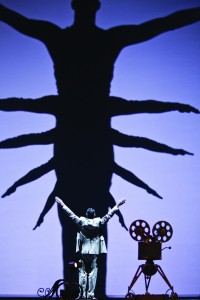 photos courtesy of Cirque du Soleil
photos courtesy of Cirque du Soleil
IRIS
Cirque du Soleil
Kodak Theatre in Hollywood
ends on January 19, 2013
for tickets, visit Cirque du Soleil/Iris
